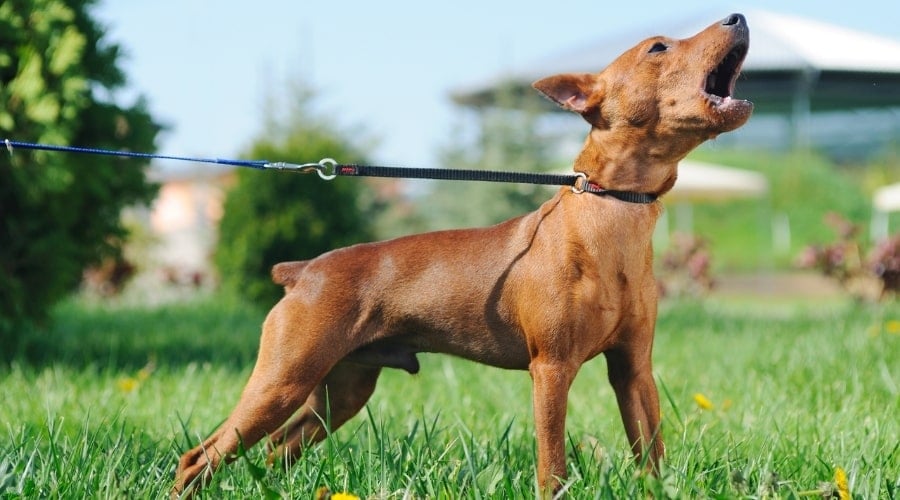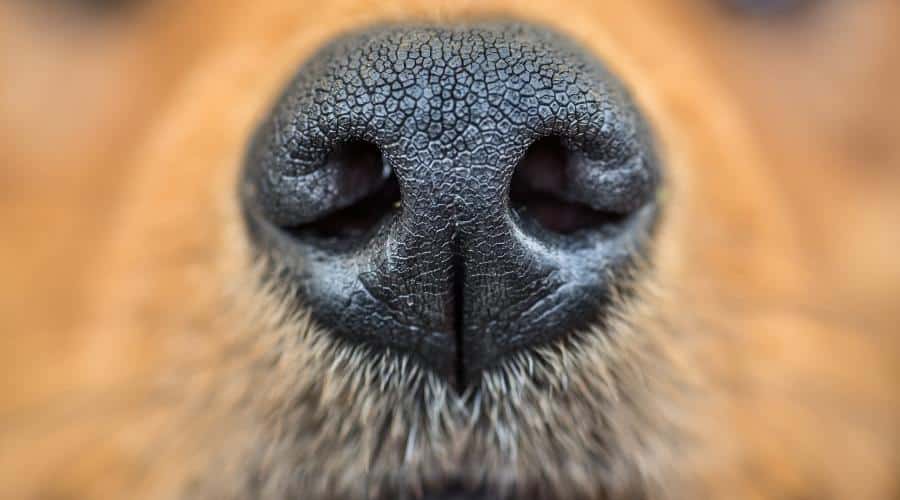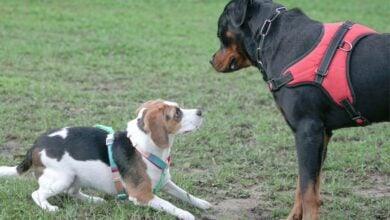Why Do Dogs Sniff Crotches? Our Researchers Dig In
When you purchase through links on our site, we may earn a commission. Here’s how it works.
If dogs ran the world, privacy wouldn’t exist. No secret would be safe—not your emotions, not your medical history, and certainly not whatever embarrassing snack you stress-ate at 2 a.m. Because in a dog’s world, your entire life is public record, and your crotch is the search bar.
Table of Contents
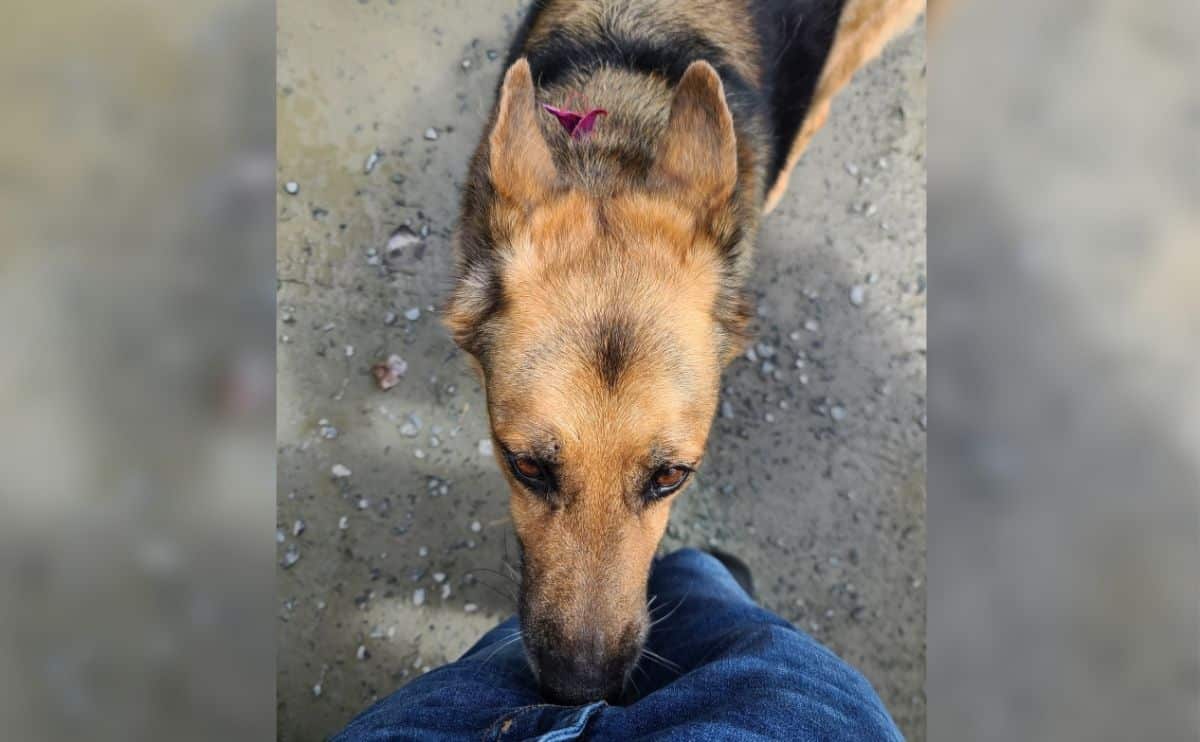
Humans tiptoe around social boundaries. We rely on Instagram stalking, passive-aggressive group chats, and painfully awkward small talk to figure each other out. Dogs? They skip the pleasantries and go straight for the biological receipts. They already know too much. Your stress levels? Analyzed. Your diet? Cataloged. Your questionable weekend decisions? Sniffed, confirmed, and silently judged. Their nose is a high-powered search engine, and your nether regions are the unfortunate Wikipedia page they keep refreshing.
But why? Are dogs just nosy little weirdos with zero respect for social norms, or is there an actual scientific reason behind this invasion of privacy? More importantly—how do you get them to cut it out before they humiliate you at your next family gathering? Take a seat on the couch—it’s time to unpack this behavior. Don’t worry; this session is free—no insurance required.
Is Crotch Sniffing Normal, Or Is Your Dog Just A Weirdo?
If your dog greets guests by diving nose-first into their personal space, you’re not alone. Many dog owners have experienced the slow-motion horror of watching their pet skip the pleasantries and head straight for the crotch. It’s awkward, invasive, and—depending on the social setting—a fast track to some uncomfortable small talk.
But here’s the truth: It’s completely normal.
Dogs rely on scent the way humans rely on conversation. We ask, “How have you been?” They smell. While we overanalyze texts, decode body language, and spend years in therapy trying to understand people, dogs solve the mystery in seconds with a single sniff. To them, it’s not rude—it’s just the most direct way to get the information they need.
But how does this actually work? What makes a dog’s nose so powerful that they can instantly read you like an open book?
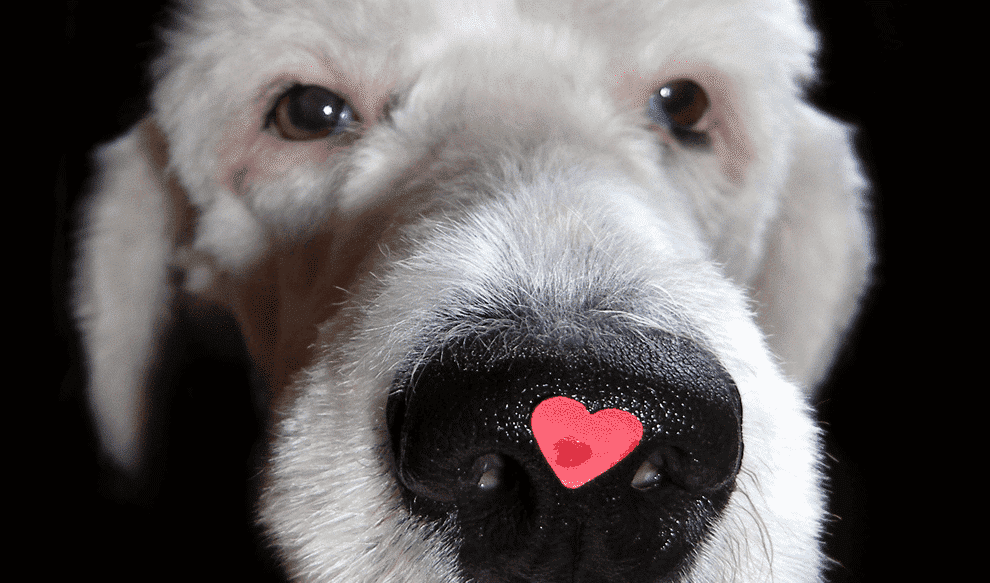
If Tinder Worked This Well, You’d Be Married By Now: The Power Of A Dog’s Nose
Dogs experience the world through their noses like we do through our eyes. If humans had the same ability, we’d sniff job applicants instead of checking resumes, skip the awkward guesswork of dating, and immediately recognize when a friend’s late-night Taco Bell run was less of a craving and more of a cry for help. Unfortunately, when it comes to scent detection, we’re operating on potato-level hardware.
Dogs, on the other hand, are biological scent-processing machines. While we muddle through life with a measly 12 million olfactory receptors, most dogs boast over 100 million. Their highly specialized olfactory system makes them 10,000 to 100,000 times more sensitive to odors than humans, and they can detect substances as small as one part per trillion. To put that into perspective, a dog could sniff out a single droplet of blood in an Olympic-sized swimming pool.
It’s not just their noses—their brains are wired for this. The area of a dog’s brain dedicated to analyzing odors is 40 times larger than that of the human brain, meaning when they sniff something, they’re not just catching a whiff—they’re running a full biochemical background check.
Dog sense of smell is strong enough to detect hormones, stress, illness, and even changes in blood sugar before medical tests do. Honestly, if dating apps worked this well, you wouldn’t have wasted six months on someone who “wasn’t ready for a relationship.”
Jacobson’s Organ: The VIP Lounge For Scents
Dogs have two scent-processing systems. First, there are the olfactory receptors in their noses, which pick up everyday smells. Canines also have the Jacobson’s organ (vomeronasal organ), which specializes in detecting pheromones and chemical signals.
Located on the roof of a dog’s mouth, the Jacobson’s organ is like a VIP access point for scent detection. When dogs really want to investigate something, they might lick their nose, flick their tongue, or even do a subtle lip curl to move scent molecules toward this specialized organ. This second olfactory system is wired directly to the brain’s limbic system, which plays a role in behavior, memory, and emotion.
The Jacobson’s organ is particularly useful for detecting pheromones, hormones, and other biological markers. It helps dogs determine who is friend or foe, which animals or humans are stressed, and even whether another dog is in heat. This second olfactory system allows dogs to better understand the world around them. They aren’t just picking up scents—they’re actively interpreting and feeling what they sniff.
Cats are famous for their “flehmen response“—that funny, open-mouthed sneer they make when analyzing a scent. While dogs are more subtle, they still use Jacobson’s organ to better understand the world around them.
So… Why Do Dogs Sniff Crotches (Scientifically Speaking)?
Dogs have an entire world of smells at their disposal, yet somehow, your crotch keeps making the top of their search history. It’s not personal—it’s just biology. To them, your nether regions aren’t just a body part. They’re a high-powered scent database, a social media profile, and a medical chart all rolled into one.
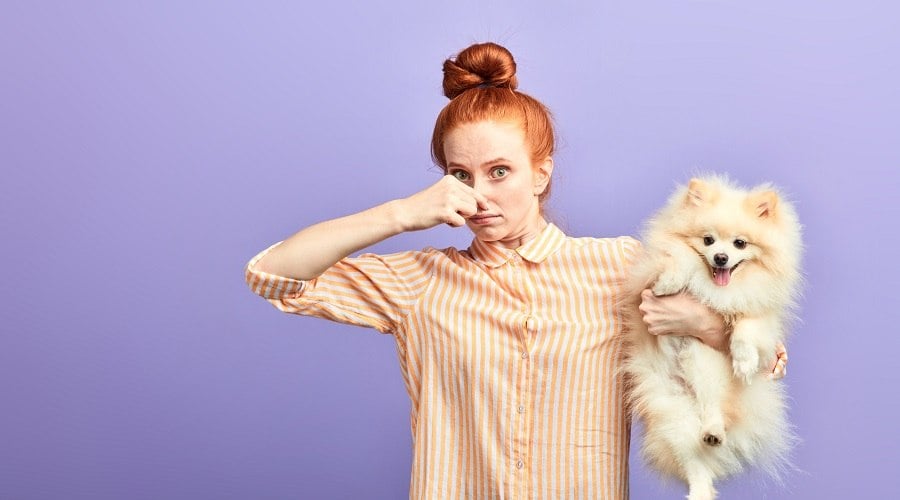
Your Body Is Broadcasting More Than You Think
The key culprit behind this behavior? Apocrine glands. These glands release bodily substances that carry personal information about an individual. Humans have them all over, but they’re most concentrated in the armpits and genital area. And since dogs can’t exactly reach up and give your pits a sniff, they go for the next best option—your crotch.
Every time they take a whiff, they’re pulling information on:
- Your emotional state (dogs can smell your stress)
- Your health status (dogs can detect illnesses, infections, and even some cancers)
- Your reproductive state (dogs can scent menstrual blood, and experts suspect they can also scent ovulation and pregnancy)
So when your dog enthusiastically shoves their nose in your business, they’re not trying to embarrass you—they’re just catching up on the latest “you” updates.
Our Personal Experience With Dogs Sensing Hormonal Changes
Many dog owners know their pups have an incredible sense of smell, but my dog, Bonkers, takes it to another level. Like clockwork, a day before my period starts, he sniffs my crotch with unwavering determination. He picks up on a scent change I’m completely unaware of, giving me an awkward yet oddly impressive monthly reminder. My other dog, Chips, is female and shows no interest whatsoever. My menstrual cycle is very irregular, and it’s quite helpful to have my own menstruation barometer. While it’s not the most dignified signal, it’s a testament to just how finely tuned a dog’s nose really is!
– Emma Braby, Dog Mom & Writer For Canine Journal
Are You Accidentally Encouraging The Behavior?
If your dog keeps sniffing your crotch every single time you walk through the door, there’s a chance you might be unintentionally reinforcing the behavior. Any reaction—laughing, pushing them away, scolding them—registers as attention. And for some dogs, attention equals a green light to keep doing it.
Social & Biological Communication: Dogs Do This to Each Other, Too
Crotch-sniffing isn’t just reserved for humans—dogs do it to each other all the time. It’s a standard way to gather information about another dog’s age, sex, reproductive status, and general health.
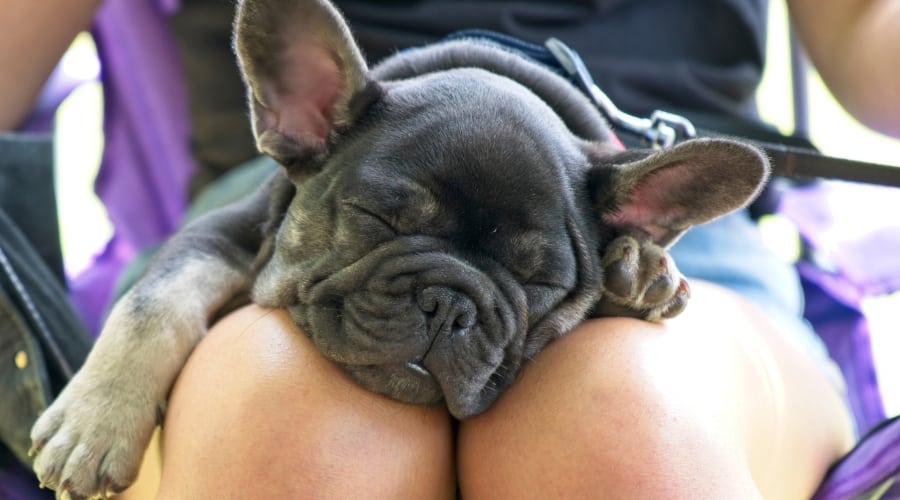
Are Some Crotches More Appealing Than Others? (And Should You Be Offended?)
If your dog ignores everyone else in the room and zeroes in on you like an ex looking for closure, you might start to wonder—is my crotch… special? Do certain people smell better to dogs? And more importantly, should you be concerned or flattered?
The short answer: Dogs don’t play favorites, but your body chemistry does. Every person gives off a unique scent, and—for some reason—yours might be sending stronger signals than others.
Science suggests that dogs are particularly drawn to:
- People experiencing hormonal fluctuations: Changes in adrenaline, cortisol, estrogen, and other hormones can amplify scent markers
- People who recently exercised: Sweat intensifies natural odors, making you stand out in a crowd
- People who have been around other animals: Your dog knows if you’ve been seeing someone else
- People who are anxious or nervous: Your body releases chemical signals when you’re on edge, and your dog is paying attention
If your dog won’t leave you alone, it’s not because they love you more—it’s because you’re chemically more interesting. Think of yourself as the main character in their scent-driven reality show.
The Crotch Sniffing Power Rankings
While science doesn’t have an official ranking system, it’s clear that dogs certainly do. If your dog gives you a quick, polite sniff, you’re just another face in the crowd. But if they’re going in for an extended investigation, you might be their most compelling case study yet.
- The “Polite Check-In”: A quick, respectful whiff. They acknowledge your presence but aren’t emotionally invested.
- The “Tell Me Everything” Sniff: Thorough, investigative, bordering on excessive. You’ve caught their attention.
- The “Therapist’s Notebook” Sniff: Deep, lingering, and way too personal. You’re an open book, and your dog is reading every page.
So, should you be offended if your dog won’t stop sniffing you? No, but you might want to ask yourself why you’re the most emotionally complex person in the room.
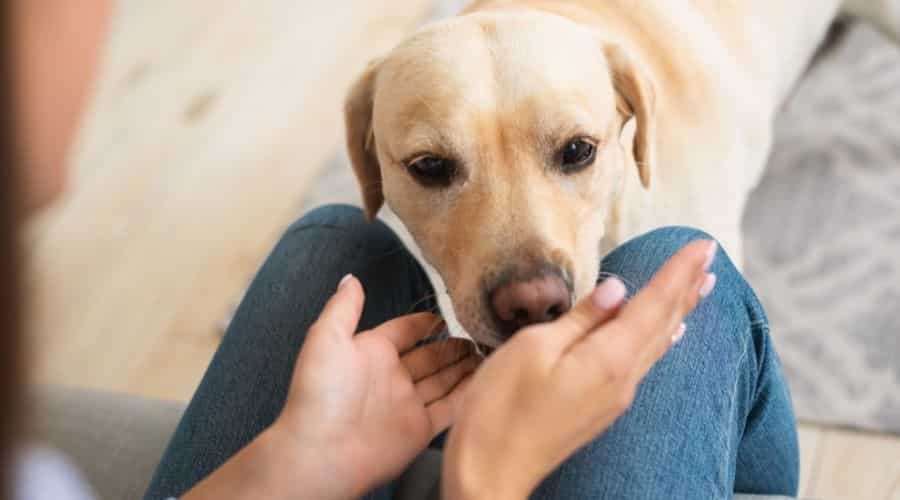
Top 5 Dog Greeting Habits: The Social Code Of Sniffing
Dogs have a structured, scent-driven approach to greetings beyond simple tail wags and excited jumps. Unlike humans, who rely on verbal cues and body language, dogs use scent as their primary way to assess new encounters. Their greeting rituals are deeply rooted in instinct, communication, and social hierarchy.
1. The Nose Knows First
The first step in a dog’s greeting process is usually a good sniff—often targeting the face, ears, or personal areas. While it might seem invasive to humans, this behavior is completely normal in the dog world. It’s their way of gathering information about:
- Identity: Who is this? Have I met them before?
- Mood and health: Are they anxious, confident, sick, or stressed?
- Where they’ve been: Have they been around other dogs, humans, or new environments?
This information is all stored in a dog’s scent profile, much like a social media bio that constantly updates with new experiences.
2. The Rear-End Handshake
While it’s awkward for humans to witness, butt-sniffing is one of the most essential parts of a dog’s greeting. The glands around a dog’s anus secrete unique scent markers that provide information on mood, stress, and readiness to mate. It’s essentially a full background check—no small talk required.
3. The Play Invite
Once the sniffing phase is complete, dogs who are comfortable with each other may initiate play. This often includes:
- The play bow (front legs down, rear end up)
- Excited tail wagging
- Bouncy movements or quick sprints (zoomies)
If a dog skips the sniffing and goes straight into play mode, they’re likely already familiar and comfortable with the other dog.
4. Sniffing Humans: The Canine Investigation Process
When greeting humans, dogs apply the same sniff-first policy. Some will politely sniff hands or clothing, while others go straight for high-information areas like the crotch. If a dog lingers on a scent, they’re processing it more deeply, similar to how humans might squint at a confusing text message.
5. Dominance vs Submission In Greetings
Dog greetings also reflect social structure. A confident or dominant dog may:
- Approach directly
- Hold their head high
- Stand tall or put their paw on another dog
A more submissive dog might:
- Approach with loose, wiggly body language
- Avoid direct eye contact
- Lower their body or roll over
Most greetings naturally balance out as dogs adjust to each other’s energy.
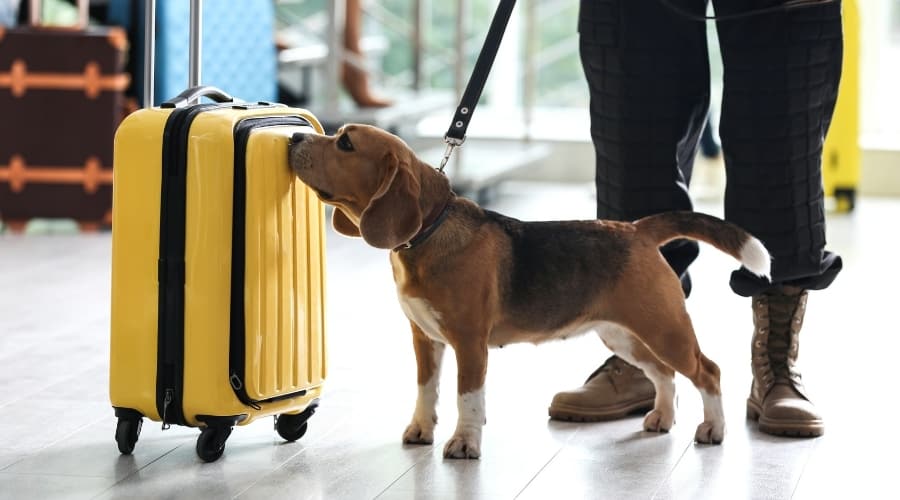
Top 4 Fascinating Facts About Dog Scent Behavior
Dogs rely on their noses to navigate the world. Their sense of smell helps them detect hormonal shifts, emotional states, and even the passage of time. Here’s how scent shapes their lives.
1. Scent Is A Dog’s Primary Language
Dogs use scent to communicate, gather information, and leave messages. Every time they investigate a tree, another dog, or even a person, they gather and leave information behind. They mark territory with urine, scratch the ground to release scent from paw glands, and rub against people or furniture to claim familiar objects. To dogs, scent is an ongoing conversation, a tracking system, and a personal ID badge all in one.
2. Dogs Use Different Nostrils For Different Smells
Studies show they favor the left nostril for familiar or neutral scents like food, while they rely on the right nostril to gather information during stressful situations, such as an unfamiliar dog or a potential threat.
3. A Dog’s Sense Of Smell May Decline With Age
Just like humans experience declines in vision and hearing, dogs can lose their ability to detect scents over time. Research has observed a degeneration in the olfactory epithelium and fewer olfactory cells in older dogs. Older dogs may take longer to process smells or show less interest in new ones, but they still show a stronger long-term memory of odors than juvenile dogs. Mental enrichment, like scent-based games or puzzle feeders, can help keep your pet’s noses sharp and engaged well into their senior years.
4. A Cold, Wet Nose Enhances Smell
The moisture on a dog’s nose helps trap and dissolve scent particles, making them easier for olfactory receptors to process.
The Canine Scent Dream Team: 13 Best Sniffers In The Business
Not all sniffers are created equal. Some breeds are professional-grade scent machines used in everything from law enforcement to medical detection. Others are incredible at home, picking up on mood changes, hidden snacks, and whether or not you’ve been around another dog.
Research shows that when comparing the olfactory ability of companion dogs, those breeds originally bred for their scenting capabilities perform best. In other words, the top sniffers may have a genetic edge when it comes to scent-based tasks, regardless of any training. So, while your couch potato Dachshund may only see a badger through Saturday streaming of Animal Planet, they still retain a stronger scenting ability than the standard dog.
That said, other factors aside from olfaction influence scenting performance, including breed stamina and trainability (e.g., desire to please and intelligence). This list narrows it down to the 13 best scent dogs, balancing professional skills with inherent olfactory ability.
1. Basset Hound
With their comically long ears, droopy faces, and short legs, Basset Hounds might not look like elite scent detectives—but never underestimate a nose that’s second only to the Bloodhound in scent receptors. These dogs were bred to track small game like rabbits and hares, and their low-to-the-ground stature helps trap scent particles closer to their noses. Their long ears and wrinkled skin even assist in catching and funneling scents directly toward their nose.
The Stubborn Super Sniffer
- Why? Second only to the Bloodhound in scent receptors, Bassets are built for slow, steady tracking
- Best for: Recreational tracking, nose work competitions
- Bonus: Too lazy to get into much trouble, but will sniff out snacks with surgical precision
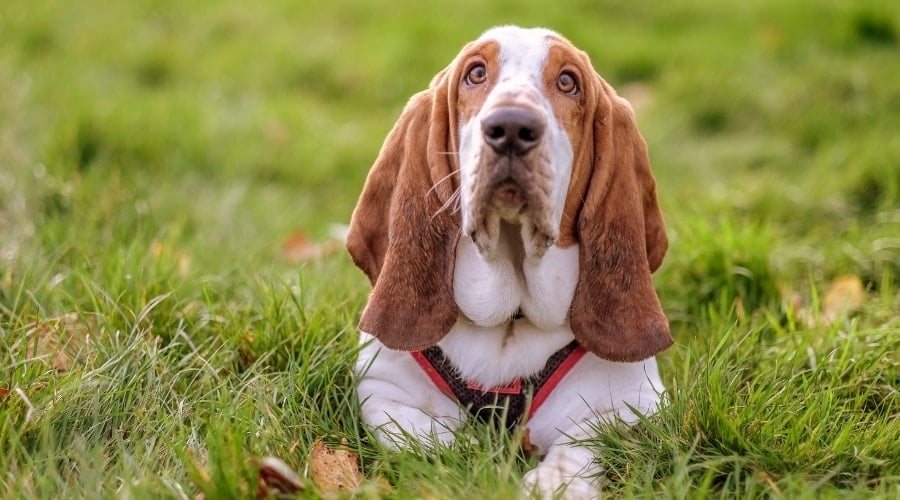
2. Beagle
Beagles may look like adorable, floppy-eared companions, but don’t be fooled—these little hounds have noses that could put an FBI agent to shame.The U.S. Department of Agriculture (USDA) uses specially trained Beagles in its Beagle Brigade to detect banned agricultural products that could introduce pests and diseases. Beagles have also been used in medical detection work, including identifying cancers, malaria, and COVID-19.
The Star Sniffer
- Why? Their compact size and relentless nose make them ideal for customs work, medical detection, and sniffing out contraband
- Best for: Airport screening, medical detection
- Bonus: Will find food in your house before you do

3. Belgian Malinois
Often used in elite military and police units, Belgian Malinois dogs are trained for explosive detection, narcotics searches, and tactical apprehension. Their speed, agility, and extreme focus make them some of the most disciplined sniffers on the planet. Malinois are known for their intensity—they take their work seriously, and once they’re on a scent, they don’t stop until they’ve found the source.
The High-Intensity Tracker
- Why? Malinois are fast, focused, and have an unmatched work ethic, making them the breed of choice for military and law enforcement detection work
- Best for: Explosive detection, narcotics searches, tracking suspects
- Bonus: If you need a dog that will analyze your every move with military precision, this is your pup
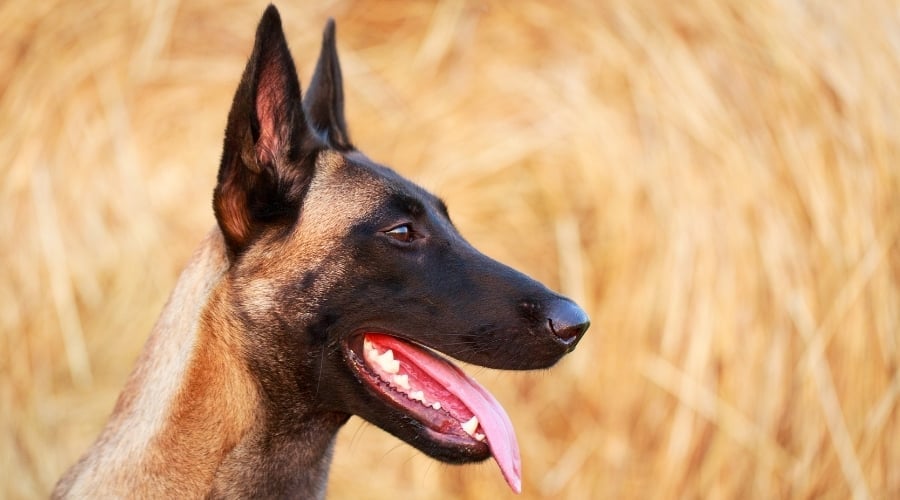
4. Bloodhound
If any breed was born for the investigation business, it’s the Bloodhound. With 300 million scent receptors (more than any other breed), Bloodhounds are living scent databases capable of tracking people or objects for miles—even days after a scent has been left behind. Law enforcement agencies and search-and-rescue teams heavily rely on Bloodhounds to locate missing persons, fugitives, and even disaster victims. Their noses are so reliable that Bloodhound evidence is admissible in court—meaning if a Bloodhound sniffs you out, you might want to lawyer up.
The Ultimate Nose
- Why? With over 300 million olfactory receptors, Bloodhounds can follow a trail days after it’s gone cold
- Best for: Tracking missing persons, search-and-rescue, law enforcement, and anyone who wants a dog that takes sniffing way too seriously
- Bonus: If you ever lose your car keys (or dignity after a night out), a Bloodhound can probably find them
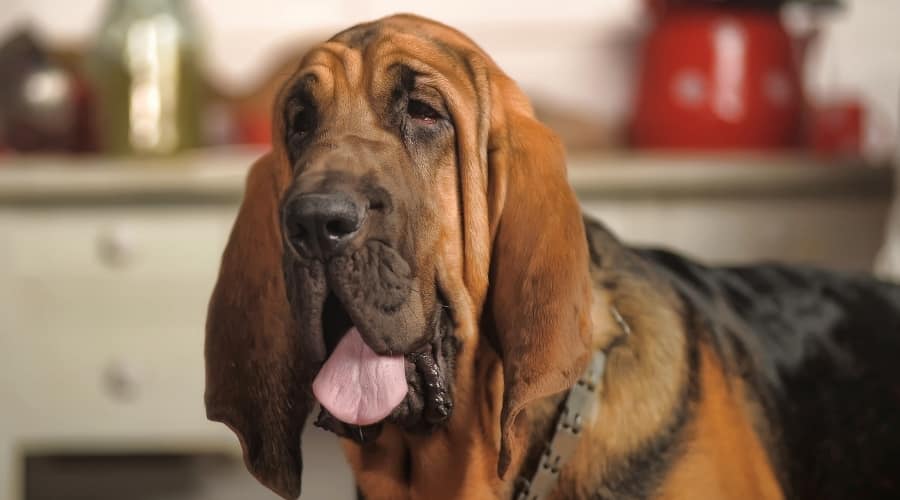
5. Border Collie
Border Collies may not have the strongest noses in the canine kingdom, but what they lack in olfactory power, they make up for in intelligence, trainability, and cooperation. A January 2025 study on breed-specific olfactory performance ranked Border Collies among the top scent performers, second only to Russell Terriers. Their incredible work ethic and problem-solving skills allow them to excel in scent detection tasks requiring precision and adaptability. Unlike some scent-driven breeds that may get distracted by a strong trail, Border Collies thrive in structured environments where they can work closely with handlers to complete complex detection tasks.
The Overachiever
- Why? Border Collies are incredibly intelligent, highly trainable, and excel in detection work that requires precision and problem-solving
- Best for: Herding, search-and-rescue, scent discrimination, medical alert training
- Bonus: If you need a dog that won’t just follow a scent but will also analyze the situation, optimize the search, and probably judge your efficiency, the Border Collie is the perfect partner
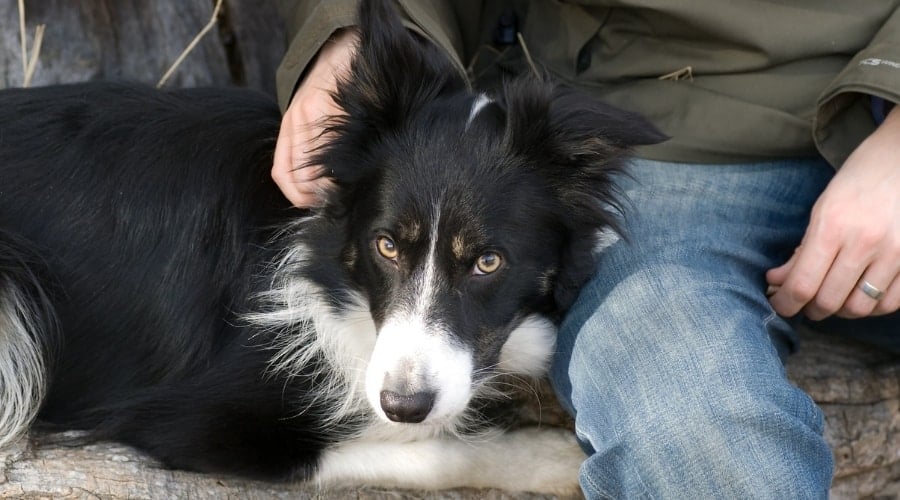
6. Bluetick Coonhound
Bluetick Coonhounds are the detectives of the hound world, known for their relentless drive, sharp intelligence, and unwavering commitment to following a scent. Originally bred in the United States for tracking and treeing raccoons, these dogs can pick up and follow even the faintest of trails, often working through rugged terrain and adverse weather conditions without losing focus. Without a job to do, they’ll find their own work, which might involve tracking every single visitor’s crotch with military-grade precision.
The Relentless Tracker
- Why? Blueticks don’t just pick up a scent—they commit to it
- Best for: Hunting, trailing, and rescue operations in rugged terrain
- Bonus: Will follow a scent trail to the fridge like their life depends on it
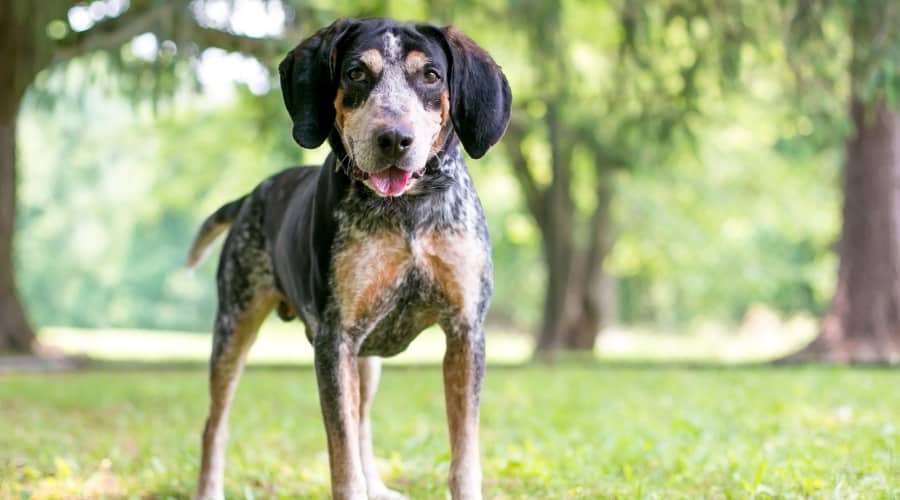
7. Cocker Spaniel
Cocker Spaniels strike the perfect balance between an intense nose and a cooperative work ethic, making them excellent candidates for scent detection. Originally bred as gun dogs for flushing out game birds, they developed a keen sense of smell and an instinct for precision tracking. Their trainability and willingness to work closely with handlers sets them apart from some other scent dogs.
The Balanced Scent Sleuth
- Why? Cocker Spaniels have a potent combination of scenting ability, trainability, and cooperative nature, making them highly effective in structured scent work
- Best for: Search-and-rescue and medical alert work
- Bonus: If you want a dog that can sniff out what you’re looking for and do it with enthusiasm and charm, the Cocker Spaniel is an ideal pick
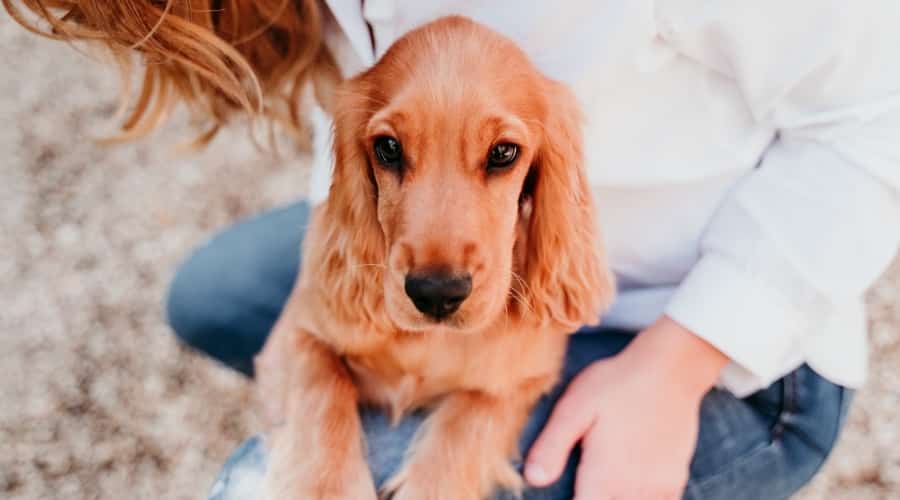
8. Dachshund
Dachshunds may be small, but their noses are shockingly powerful. Initially bred to hunt burrowing animals like badgers, they rely heavily on scent tracking to locate prey underground. However, Dachshunds have an independent streak, so getting them to focus their skills on anything other than digging up your yard might require some effort.
The Small But Mighty Sniffer
- Why? Dachshunds may be short in stature, but their noses are incredibly powerful
- Best for: Nose work competitions, recreational tracking, hunting small game
- Bonus: If you lose something in the house, your Dachshund will find it, whether you want them to or not

9. English Springer Spaniel
English Springer Spaniels are high-energy, highly intelligent, and ridiculously good at sniffing things out. Initially bred for flushing game birds from dense brush, Springers have evolved into some of the best detection dogs in the world, working in fields like bomb detection, drug searches, and even medical alert services. Their versatility sets them apart—while some scent hounds focus on tracking, Springers excel at air-scenting and ground tracking, making them incredibly effective in search-and-rescue missions.
The Energetic Detector
- Why? Springer Spaniels combine enthusiasm, intelligence, and an incredible nose
- Best for: Drug and explosive detection, search-and-rescue, medical alert services
- Bonus: Will detect your bad moods and insist on cheering you up
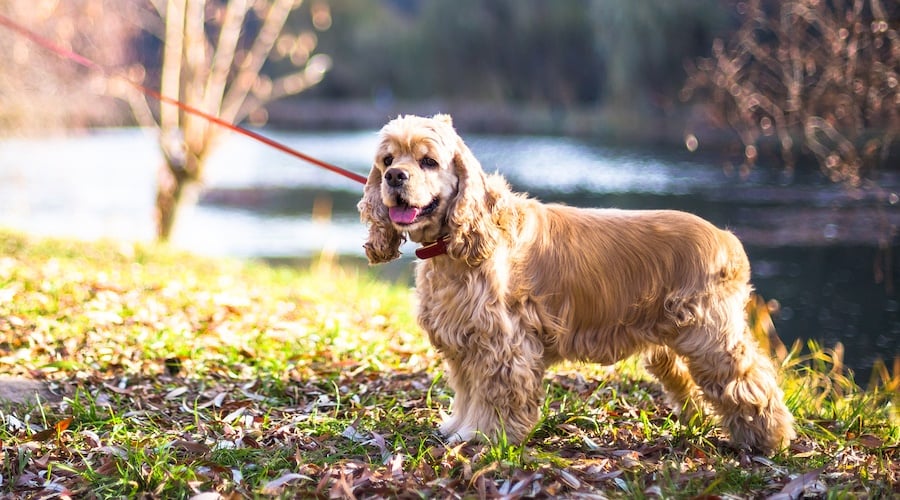
10. German Shepherd
When it comes to versatility, German Shepherds dominate the working dog world. Used by police, military, search-and-rescue teams, and even medical detection programs, this breed is the Swiss Army knife of sniffers. They’re excellent for long-term investigative work, including tracking suspects or detecting diseases.
The Intelligent Investigator
- Why? A brilliant working dog with an exceptional ability to retain scent memories
- Best for: Cadaver detection, search-and-rescue, police work
- Bonus: Will alert you if someone suspicious walks by, even if it’s just the mailman
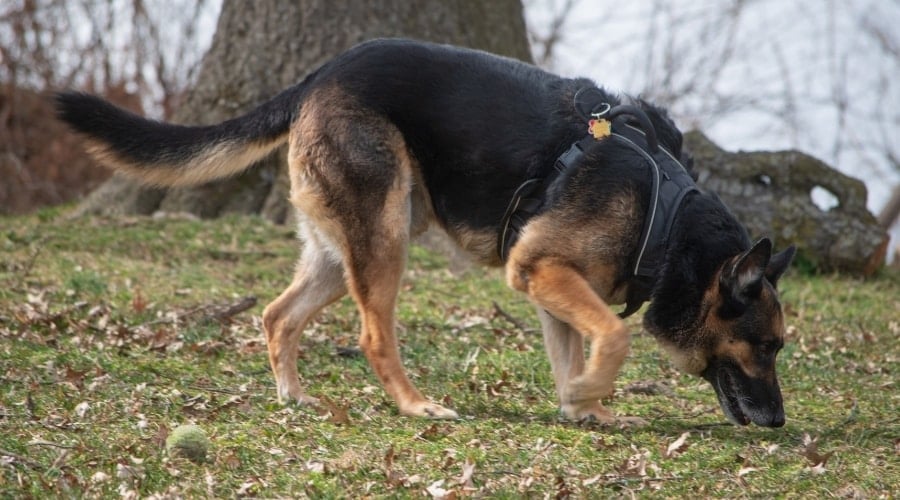
11. German Shorthaired Pointer
German Shorthaired Pointers are fast, focused, and laser-accurate in their scent work. Initially bred for hunting and retrieving, their noses are so precise that they’ve been trained for specialized tasks like cadaver detection, narcotics searches, and even conservation work. Unlike some hounds that methodically follow scent trails, Pointers don’t just follow scents blindly—they assess, analyze, and adjust their strategy on the fly.
The Precision Sniffer
- Why? German Shorthaired Pointers are fast, strategic, and highly intelligent scent trackers that excel in both hunting and professional detection work
- Best for: Hunting, cadaver detection, narcotics searches, conservation work (tracking endangered species or detecting invasive animals)
- Bonus: If you’re looking for a dog that will keep tabs on your every move and insist on being included in all household activities, a German Shorthaired Pointer is your built-in investigative partner
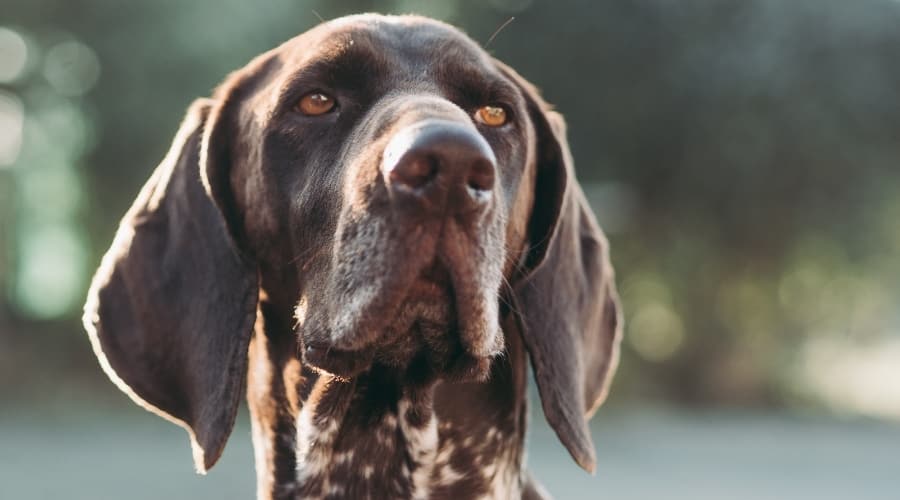
12. Labrador Retriever
Labrador Retrievers are the gold standard for detection dogs. Their powerful noses, combined with an unmatched work ethic and trainability, make them the top choice for bomb and drug detection, medical alert services, and even conservation efforts. Labs have been trained to sniff out everything from contraband at airports to endangered animal scat in the wild.
The Most Versatile Sniffer
- Why? Labs are reliable, methodical, and incredibly trainable, excelling in drug detection, medical alert services, and search-and-rescue
- Best for: Bomb and drug detection, diabetes and seizure alerts, disaster response
- Bonus: Will sniff out food crumbs and alert you to the exact moment you open a snack, no matter how quietly

13. Russell Terriers
Russell Terriers may be compact, but their scenting ability is nothing short of elite. In a January 2025 study on breed-specific olfactory performance, Russell Terriers ranked highest among all tested breeds, outpacing even traditional scent hounds. Their keen noses, intense drive, intelligence, and problem-solving skills make them exceptional in scent-detection tasks that require focus and determination. Initially bred for hunting and flushing out prey, Russell Terriers are hardwired to track, locate, and alert with unmatched enthusiasm. This trait makes them valuable for professional detection and nose work competitions.
The Small Dog With A Big Nose For Success
- Why? Russell Terriers have exceptional scent detection skills, high intelligence, and relentless determination
- Best for: Nose work competitions, scent discrimination, hunting, search-and-rescue in small spaces
- Bonus: If you need a dog that treats every scent like a high-stakes investigation and won’t stop until they have answers, a Russell Terrier is for you
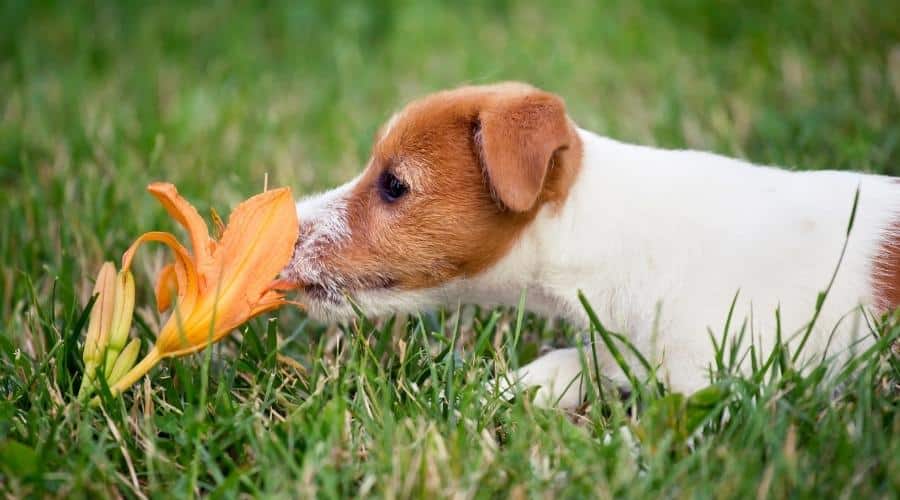
Worst Sniffers: When Short Noses Come Up Short
While many dogs have noses built for high-powered scent detection, some breeds aren’t equipped for the job. Research supports the assumption that short noses have a negative effect on scenting. Thus, when looking strictly at olfactory ability (and excluding trainability and motivation), short-nose dog breeds tend to be the worst sniffers.
This may be connected to brachycephalic syndrome in dogs, a condition that is common among short-nosed breeds and negatively impacts the movement of air through the nasal passages. Less air movement means less scent processing ability.

So, while these dogs may excel in companionship, charisma, and couch-warming skills, they aren’t winning any nosework competitions anytime soon.
- Bulldog
- Boxer
- Boston Terrier
- Cavalier King Charles Spaniel
- Pug
For a full list of brachycephalic dogs, view our list of 19 flat-faced breeds.
Our Personal Experience With Dog Crotch Sniffing
My husband and I had a dog named Iris, a Beagle Golden Retriever mix, who was a big-time crotch sniffer. She was a good dog, but boy, was she pushy. This dog was always there waiting after anyone used the bathroom, just ready for an opportunity to sniff. She often got pushier with my husband’s male friends, especially when we had larger gatherings. One of my friends joked all the time about visiting us just to see the dog when he was feeling lonely because she was such a “flirt.” While a funny joke, it was certainly embarrassing to apologize to everyone who came over for Iris’s very forward behavior.
One of my dogs now, Daisy, a Labrador Pitbull mix, has always been a crotch sniffer as a way of greeting both males and females. She is the perfect height for it, too. As she has aged, Daisy has gotten more aggressive with the crotch sniffing. This dog will literally meet me at the door and make a forceful attempt to get as close to me as she can as soon as possible anytime I come home. If I am cooking or doing something in the kitchen, she is always there, directly behind me, just waiting to take a sniff. It is not a behavior that anyone in the family likes. We will reinforce training periodically, and she will tone it down, but she always amps back up again. Now, we have started leaving her in a room when we go out rather than having the entire run of the house so that we can get in the door without fear of a wet nose in the crotch.
– Danielle DeGroot, Rescue Dog Mom, Canine Journal Research & Writer
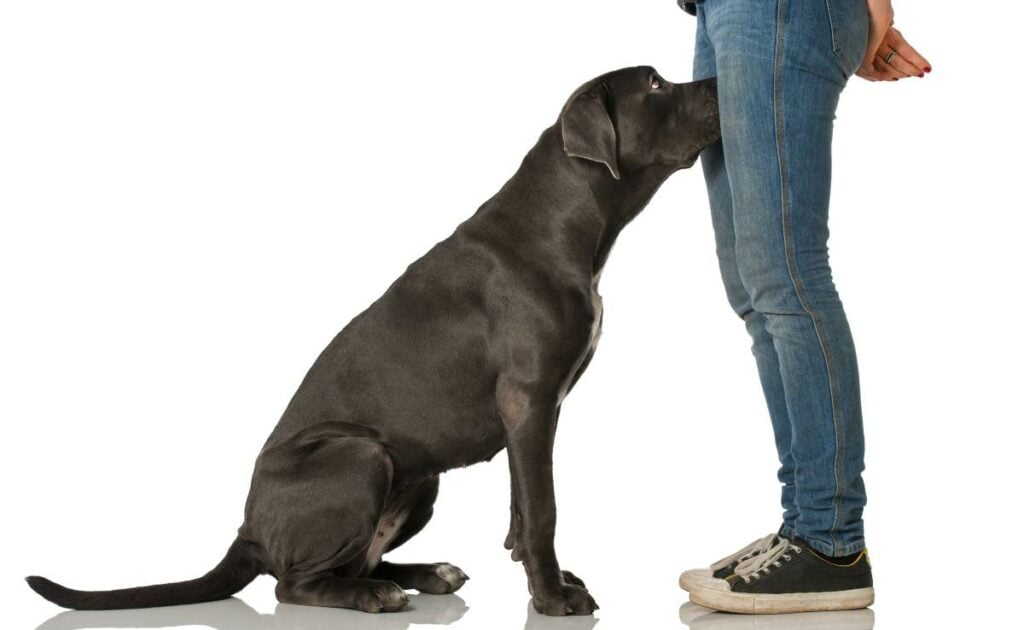
How Do I Stop My Dog From Investigating My Guests’ Nether Regions?
While crotch-sniffing is a natural behavior, that doesn’t mean you have to accept it as part of your dog’s social routine. With some training and redirection, you can teach your dog that not every introduction needs to be that personal.
Teach The “Sit” Command
One of the best ways to prevent crotch-sniffing is to redirect your dog’s focus before they even get the chance to dive in. Teaching a firm sit command gives them something else to do when guests arrive.
Reward Nose-To-Hand Greetings
If your dog is going to sniff, at least make it socially acceptable. Teaching them to greet people by sniffing a hand instead of other areas gives them the information they want without the full-body invasion.
- When introducing your dog to someone new, encourage the person to offer their hand at your dog’s nose level while keeping other body parts out of reach
- Reward your dog with praise or treats when they sniff the hand instead of making a beeline for the crotch
Interrupt And Redirect Before It Happens
If you know your dog is a serial crotch-sniffer, catch them before they make their move.
- Keep them on a leash when guests arrive so you can gently guide them away from inappropriate sniffing
- Use a cue like “leave it” or “uh-uh” to signal that sniffing isn’t welcome
- Immediately redirect their attention to an acceptable alternative
Manage The Excitement Level
Some dogs get extra sniffy when they’re overstimulated. High-energy dogs, in particular, may be more prone to diving nose-first into a guest’s business because they’re too excited to think clearly. Before guests arrive, burn off some of that energy with a long walk, a game of fetch, or mental enrichment activities.
Avoid Accidentally Reinforcing The Behavior
Even if you’re mortified when your dog sniffs a guest’s crotch, your reaction might be encouraging them. Laughing, pushing them away, or even making a big fuss can register as attention, which some dogs see as a reward. Instead of reacting dramatically, stay calm, interrupt, and redirect without making it a big event.
Teach The “Go Say Hi” Cue (With Boundaries)
If your dog enjoys greeting people, teach them a structured “go say hi” command.
- Only allow them to approach when they are calm and under control
- Reward them for polite greetings that don’t involve deep diving into someone’s personal space
Use Management Tools If Necessary
If your dog is particularly persistent, tools like leashes, dog gates, or even a well-timed treat scatter can help keep their greetings appropriate while you reinforce better habits.
Frequently Asked Questions
Here are some questions we’re frequently asked about dog sniffing. Don’t see yours? Ask us in the comments!
Do Dogs Sniff Crotches Because They Weren’t Socialized Properly?
No, this isn’t a behavioral issue. Even well-socialized, perfectly trained dogs may engage in crotch-sniffing because it’s a natural part of their greeting process. The key is teaching them an alternative way to say hello.
Is Crotch-Sniffing A Dominance Thing?
Not really. It’s more about curiosity than control. While dominant dogs may have more confident body language when sniffing, the act itself isn’t about asserting power—it’s just their way of saying hello.
Is Crotch-Sniffing More Common In Puppies?
Yes! Puppies explore the world through their noses, and they’re still learning what’s socially acceptable. As they grow older, they may become more subtle about it.

Does Your Dog Demonstrate Other Unwanted Behavior?
If your furry sidekick needs to work on her manners or other problem behaviors, you may want help from a professional dog trainer. See our reviews of the best online dog training courses and dog training apps to find affordable training assistance. Some of these options even give you virtual access to professional dog trainers.
Does your pup sniff your crotch or butt? Let us know in the comments!
Why Trust Canine Journal?
Tara is part of the Canine Journal team, which has over a decade of experience researching, testing, and writing about anything and everything dog-related. Most of our team members are lifelong dog owners and can provide personal insights on each topic we cover.
